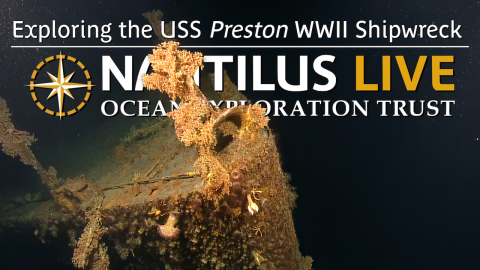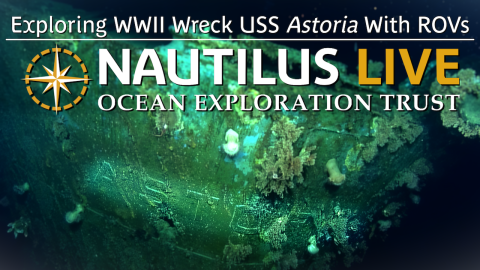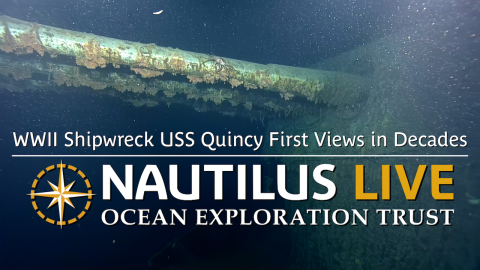Shipshape - A Guide to Naval Vessel Classes of the Solomon Islands Campaign
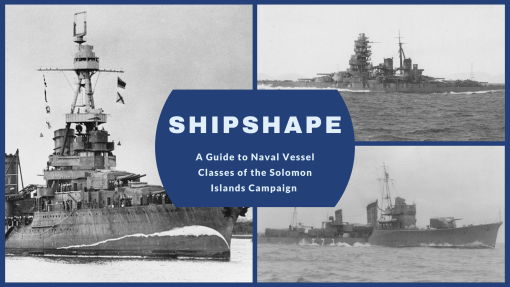
This blog was contributed by Ocean Science Intern William Fallon.
During the Maritime Archaeology of Guadalcanal (NA173) expedition, the Corps of Exploration is conducting non-invasive archaeological surveys of historically significant shipwrecks in the Iron Bottom Sound. Located in the Solomon Islands, this confined water sound was the stage of five major naval battles during World War II. Over one hundred vessels were sunk here, leaving maritime heritage sites that illustrate the United States, Royal Australian, and Imperial Japanese Navies technology of the time. Learn more about the vessel classes and their key differences as the team explores the seafloor.
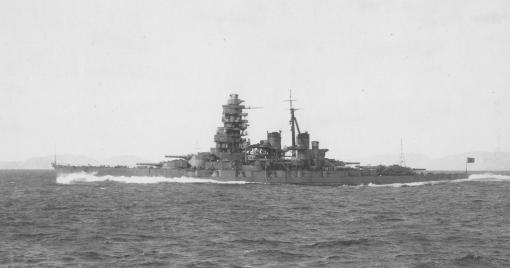
Japanese battleship IJN Hiei.
Battleships
Role: Battleships are the big guns of a navy, literally. Heavily armored and armed with massive guns capable of firing up to twenty miles, battleships are built to dish it out and take hits. Battleships tend to be the flagships of a navy, showcasing the might and power a country possesses. They are often used for shore bombardments, naval engagements, and protecting valuable targets such as carriers.
Armor: The armor battleships carry is the thickest at sea. The citadels of battleships are their most armored areas; citadels are basically large armored boxes protecting the critical systems of a ship, such as the engine, ammunition storage, and command and control spaces. The citadel is typically situated along the waterline and consists of armor, usually one to one and a half feet thick. Apart from the citadel, battleships are covered in armor all over, on the deck, the sides, and the gun turrets themselves. Many battleships also had extra protection from underwater threats in the form of torpedo belts. Torpedo belts were a line of lightly armored watertight compartments built underwater on the sides of ships, meant to dissipate the force from underwater explosions.
Armaments: Battleships’ main armaments are their massive guns. Carrying the biggest at sea, battleship guns can be over a foot and a half thick, but 14-16 inches are the most common bore sizes. These guns are capable of hitting targets over twenty miles away! For their secondary armament, battleships will usually carry several smaller guns, often positioned along their sides for closer-range engagements. These guns are often the caliber of a destroyer's main gun, at around five to six inches. Battleships were also covered in anti-aircraft guns, most common were machine guns and 20 to 40 mm cannons, but some ships carried larger flak cannons upwards of 70 mm. Oftentimes, battleships had catapult systems used to launch spotting seaplanes, located usually amidships or at the stern. Cranes were also present to pick up seaplanes that landed in the ocean next to the ship.
Visual Identification: Battleships are easily identifiable by their size, typically ranging from 200 to 250 meters in length. Amidships usually lie a massive superstructure that often contains the bridge, radio towers, command center, and fire control systems. They are often very tall for spotting purposes. Behind the superstructure is often where the smokestacks are located. Battleship main gun turret placement can vary greatly, but most often, battleships will have three or four main turrets, with two or three guns per turret. Often, two turrets are placed fore, in front of the superstructure, with the turret closest to the superstructure raised above the foremost gun. The remaining turret(s) are usually then placed aft. Placement can vary greatly, however, with some battleships having up to six turrets, with some placed amidships! Aircraft catapults were often located on the stern of battleships.
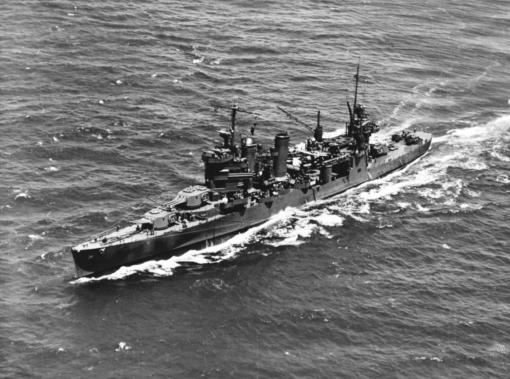
Cruiser USS Astoria
Heavy and Light Cruisers
Role: Cruisers are very versatile and can fill a number of roles by balancing firepower, armor, and speed. Cruisers are often used to escort carriers, where their anti-aircraft capabilities are especially useful. They are also great for mid-range naval combat, with their medium-sized guns capable of targeting enemies at approximately fifteen miles. Overall, cruisers are the jack-of-all-trades for a navy.
Armor: Cruisers are armored more so than destroyers but less than battleships. While the thickness varies between classes, nations, and types of cruisers, generally, cruisers follow the same armor pattern. Cruisers will be most armored around their main belt, part of the citadel on the sides of the ship. Often, cruisers will also possess a thick armored deck to protect from plunging fire coming from high angles. Cruisers usually do not have as thick side armor as battleships, and many lacked torpedo belts.
Armaments: Cruisers’ main armaments are their cannons. Cruisers typically have cannons with a bore of six to eight inches, depending on the cruiser and whether it is a heavy or light cruiser. Heavy cruisers could carry guns up to eight inches, while light cruisers usually had five-inch guns. These cannons are housed in multiple turrets, typically featuring two or three guns per turret. Light cruisers tend to carry more guns than heavy cruisers to compensate for the smaller gun size. Some cruisers are also equipped with torpedoes stored amidships or in tubes on each side of the ship. Cruisers are also often equipped with substantial amounts of anti-aircraft weaponry, commonly including machine guns and 20 mm cannons. Light cruisers, in particular, have a significant amount of anti-aircraft weaponry. Similar to battleships, many cruisers carried seaplane catapults and recovery cranes, often found amidships.
Visual Identification: Cruisers are smaller than battleships but larger than destroyers, usually around 150-200 meters long. Cruisers have large superstructures similar to battleships, but they tend not to be as tall. For gun placement, it varies greatly. Turrets are usually placed fore and aft, often with three and two respectively for light cruisers. Heavier cruisers may only have two fore and one aft. Older American cruisers typically housed their plane catapults amidships, whereas newer ones located them at the stern.
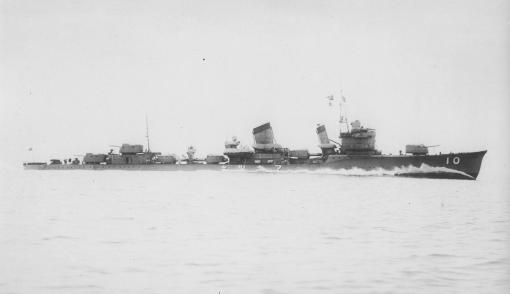
Destroyer IJN Akatsuki
Destroyers
Role: Destroyers tend to be small, fast, and maneuverable, with little armor and "small" guns; they make up for it in their speed and torpedo armaments. Destroyers excel at reconnaissance, their small size allowing them to remain undetected for longer periods than heavier ships. Destroyers were often tasked with anti-submarine warfare. Using sonar to detect underwater threats, depth charges would then be used to destroy any subs attacking or approaching a friendly vessel or fleet. Destroyers were often equipped with radar used for detecting surface threats and aircraft.
Armor: Destroyers are usually equipped with very little armor, usually only 6-20 mm. This armor is not designed to withstand large guns or bombs of any kind. Destroyers mainly use their speed to rely on not getting hit as opposed to tanking shots like cruisers and battleships.
Armament: Destroyers possess small guns (relative to other ships), usually around five inches in caliber. These guns are usually in a single or dual gun turret. Lesser equipped destroyer classes may only have two guns, fore and aft. The Destroyer's other main armaments are torpedoes. Launched from tubes of 2-4, torpedoes are fast-moving underwater arms with explosives on the end. When they reach their target, they explode below the waterline, causing massive damage and flooding. For anti-aircraft armaments, machine guns and 20 mm gun emplacements are common on most destroyers. Destroyers were also often equipped with numerous depth charges used in anti-submarine warfare (ASW).
Visual Identification: Destroyers are easily distinguishable from other surface vessels due to their small size and low profile, which tends to be thin and elongated. The gunwales of a destroyer will almost always be lower to the waterline than those of other warships. Destroyers tend not to have large superstructures; instead, a small bridge is usually situated about one-third the boat's length from the bow. It is common to see World War II destroyers with two smokestacks, but this is not a defining feature. When identifying a destroyer, the placement of its weapons is also important. Destroyers usually have a deck gun at the fore and aft ends, with more than one being at each end, depending on the class. Torpedoes are often found midship, often between the smokestacks and gun emplacements.
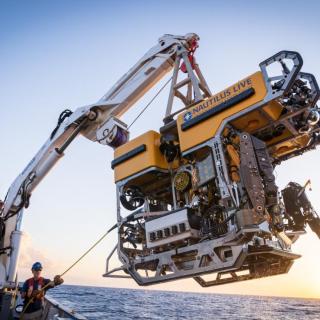
Maritime Archaeology of Guadalcanal: Iron Bottom Sound
Located in the Solomon Islands between the islands of Guadalcanal, Savo, and Nggela, Iron Bottom Sound was the stage of five major naval battles between August and December 1942 which resulted in the loss of over 20,000 lives, 111 naval vessels, and 1,450 planes. These underwater cultural heritage sites now rest on the seafloor offshore Honiara in a confined area less than 25 nautical miles wide, 40 nautical miles long, and 1,400 meters deep.
